Marrying Vega and Zen: The AMD Ryzen 5 2400G Review
by Ian Cutress on February 12, 2018 9:00 AM ESTiGPU Gaming Performance
Throughout their history of having fully integrated GPUs, AMD has always favored going for powerful configurations that approach the lower-end of discrete GPU performance. With comparable discrete cards going for $80 or more, a powerful iGPU is a significant value proposition for AMD’s APUs. Furthermore as Intel has continued to stick with relatively lightweight iGPUs for most mainstream SKUs – a trend even the newly released “Coffee Lake” 8th Gen Core family continues – AMD has easily trounced Intel’s iGPU performance.
In fact the most recent 8th Gen Core CPUs generally fail to catch up to AMD’s last-generation 7000/8000 series “Kaveri” APUs, which means that for the launch of AMD’s new Ryzen APUs, the manufacturer is just going to be running up the lead even more. The real question we’ll be looking at on the iGPU side isn’t what’s faster – that’s obvious – but just how many times faster the 2400G & 2200G APUs are over their Intel equivalents, and how they stack up against an entry level discrete video card, the GeForce GT 1030. With upwards of 11 CUs in an APU, on paper the Ryzen APUs should be able to offer 1080p@30fps gaming at maximum (or near-maximum) image quality.
During our pre-briefing, several sets of benchmarks and configurations were 'suggested', focusing on eSports and a mid-range quality setting, to show what the platform can do. For our testing, we used our CPU Gaming 1080p gaming suite. This suite was developed with mid-range and high-end graphics cards in mind, with mostly high or ultra quality settings, pushing beyond what was suggested. The reason we did this was two fold:
- In our data, it shows a sizeable difference between integrated graphics solutions that can offer potential, compared to those that fall at the first hurdle.
- Second, it offers a stark reminder that while for the most part websites and enthusiasts like as way lyrical about high-end performance, the data shows both how far integrated graphics has come, and how far it still has to go to qualify for those 'immerse experiences' that Intel, AMD, and NVIDIA all claim are worth reaching for, with higher resolutions and higher fidelity.
Civilization 6
First up in our CPU gaming tests is Civilization 6. Originally penned by Sid Meier and his team, the Civ series of turn-based strategy games are a cult classic, and many an excuse for an all-nighter trying to get Gandhi to declare war on you due to an integer overflow. Truth be told I never actually played the first version, but every edition from the second to the sixth, including the fourth as voiced by the late Leonard Nimoy, it a game that is easy to pick up, but hard to master.
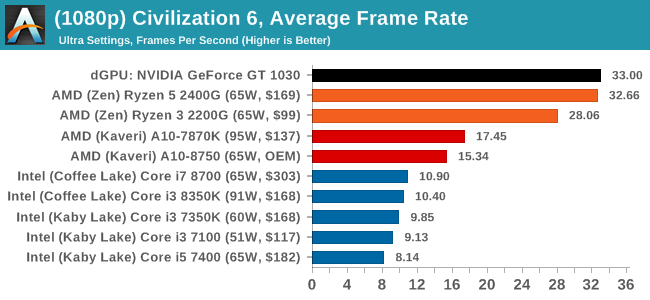

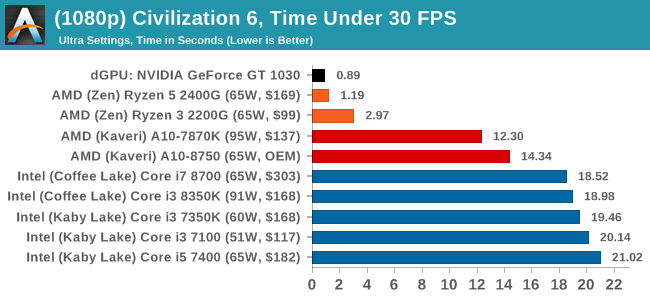
While Civilization is not too limited to frame rates, the APUs straddle the 30FPS average, and the GT 1030 comes out on top just about. Intel's integrated graphics options are only 1/3 of what AMD is providing in this case.
Shadow of Mordor
The next title in our testing is a battle of system performance with the open world action-adventure title, Middle Earth: Shadow of Mordor (SoM for short). Produced by Monolith and using the LithTech Jupiter EX engine and numerous detail add-ons, SoM goes for detail and complexity. The main story itself was written by the same writer as Red Dead Redemption, and it received Zero Punctuation’s Game of The Year in 2014.
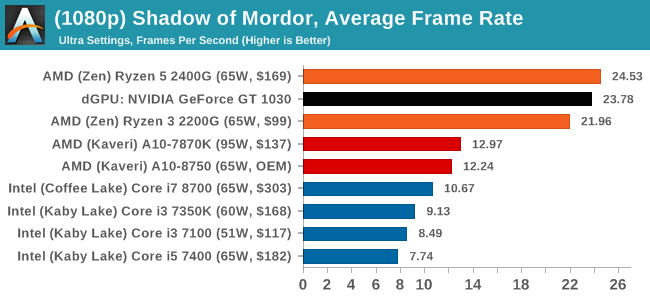
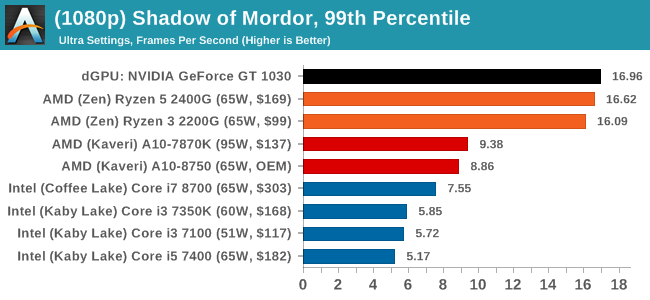
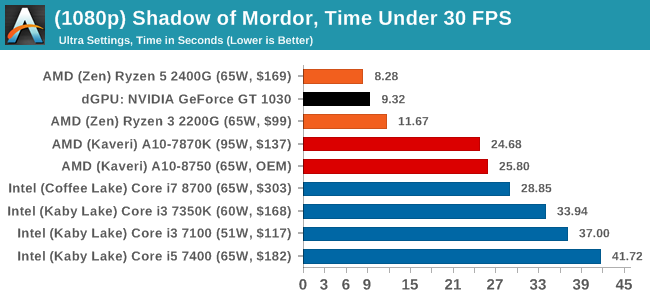
In Shadow of Mordor, the 2400G takes the top spot in average frame rates, but the GT 1030 just wins on percentiles. Over Kaveri, AMD is now offering double the graphics performance, and over Intel, AMD is easily 2-3x in performance per dollar.
Grand Theft Auto V
The highly anticipated iteration of the Grand Theft Auto franchise hit the shelves on April 14th 2015, with both AMD and NVIDIA in tow to help optimize the title. GTA doesn’t provide graphical presets, but opens up the options to users and extends the boundaries by pushing even the hardest systems to the limit using Rockstar’s Advanced Game Engine under DirectX 11. Whether the user is flying high in the mountains with long draw distances or dealing with assorted trash in the city, when cranked up to maximum it creates stunning visuals but hard work for both the CPU and the GPU.
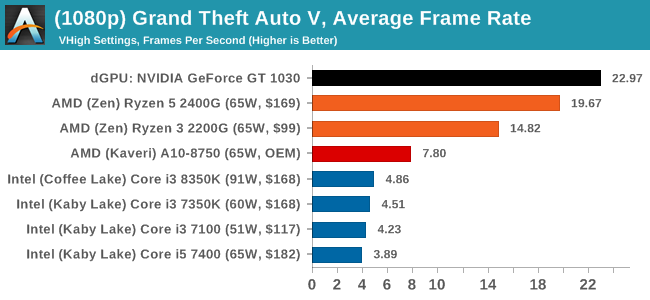
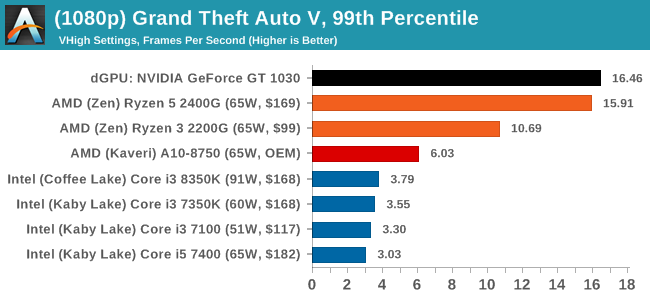

The difference between something playable and a slide show was easily noticable in GTA. The GT 1030 had the legs on this one, although the gap between the two AMD parts was mostly noticable in 99th percentile numbers.










177 Comments
View All Comments
Gonemad - Wednesday, February 14, 2018 - link
These chips will cause a major segment of low-end graphics cards to be buried, or have their prices cut down. I can't wait for the benchmarks, and see how many generations will be affected.callmesissi - Wednesday, February 14, 2018 - link
what an amazing apu... this makes all celerons / pentiums and half of i3 completely out of market! this apu is so good, so cheap, kills all the entry level gpus and basically all those intel cpus mentioned .way to go amd! now about those drivers and bios....
edlee - Thursday, February 15, 2018 - link
this is amazing by AMD, they need to keep the hits coming, and chipping away market share from intel. Intel has not made any progress on processor graphics in years, this is a super aggressive strategy by AMD that i think will work. Nvidia basically has to cancel out any gpu line below gtx 1030 by next year. Hopefully AMD comes out with a GTX 1050 killer by next year.CSMR - Wednesday, February 14, 2018 - link
I think the relevant Intel comparisons would be processors with Iris Pro or Iris Plus.Hixbot - Wednesday, February 14, 2018 - link
Do these APUs not compete directly with the new Intel-Vega chips? Why did AMD give Intel Vega, when AMD could have had the APU market all to themselves?SaturnusDK - Wednesday, February 14, 2018 - link
Not really. The i8809G as it's called is supposedly a mobile part if you can call a 100W TDP part mobile by any stretch of the imagination. It's based on a 22 (or 24) CU Vega and will be much much more expensive. Expect it to land somewhere in the $400+ range, ie. more expensive than an 8700Kfranco1961 - Thursday, February 15, 2018 - link
Hi Ian. Two questions: I have to do a cheap PC for video editing (Adobe Premiere, After Effcets, etc.) and I thought about a Ryzen 3 1200 and a Geforce GT 1030. You think this Ryzen 5 2400G goes for video editing by having a Vega 11? Another question: using DDR4 2400 would I have a strong performance drop or could it be okay? Thank you!rexian96 - Thursday, February 15, 2018 - link
A question for Ian or anyone who knows - Does 2400G not support HW encoding of H264/265 and just limited decoding? Or that Handbrake doesn't support it yet? Looking at the encoding score it would seem 8400 is miles ahead though the GPU in Ryzen is much stronger.csell - Friday, February 16, 2018 - link
Hi. Do you know the max videoram?Will it be possible to use Crossfire between the shared ram and a graphics card?
If crossfire will be limited to VEGA graphics card, will I hope AMD will introduce a cheap graphics card with just 8 or 11 Vega compute units and may be HDMI 2.0
SaturnusDK - Friday, February 16, 2018 - link
There will be no crossfire with dGPUs. It's no possible at all.